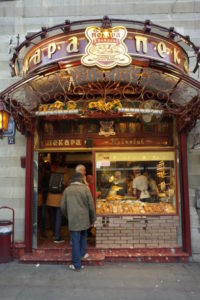(Pictures by Sr. Kilgore, text by Kilgore and Belew.)

Off to Belgrade, Serbia. Transitions are tricky.
Arriving in Belgrade we faced such high class problems as a cabbie who charged triple fare (it was Sunday) and an apartment host that was hard to reach. We waited for more than an hour on the street until Nikola arrived to let us into our really nice apartment in the old part of town.
(note from EB: at the time, I could sound out this word. Turns out the use of Cyrillic is, in Belgrade, mixed with the Latinate (sort of our alphabet) version of Serbian/Serbo-Croatian. The catch is that there is a sort of cursive version of the Latinate, which sent me back to redo my cheatsheet, and return to fairly full-on illiteracy.)
 The Elevator warned kids not to fool around with the controls.
The Elevator warned kids not to fool around with the controls.
(What is the number for 911?)
(EB: Belgrade is a city worth exploring. The roaming Serbian police give me a chill, however: mostly BIG guys, who reminded me of the Minneapolis cops of the early 70s as they cruised through crowds, or through the train cars, stopping to double check the papers of men of color.)
Best Pastry shop in Belgrade.

And indeed, the pastries were delicious.
Our Belgrade tour guide- born in 1991-(whose name we never managed to pronoune correctly), helped us see the Yugoslav conflict of the 1990’s from a Serbian point of view. She credited her facility with languages to the time spent watching TV inside her apartment avoiding NATO bombing dangers. Because Serbian is a lesser-used language, telenovas are shown with subtitles- not dubbed.
 She had some sophisticated observations on the conflict. She thought the different leaders of the different nations overestimated their position of power and each wanted to take more than they could hold- and that the Serbian leader, at least, overestimated his intelligence as well.
She had some sophisticated observations on the conflict. She thought the different leaders of the different nations overestimated their position of power and each wanted to take more than they could hold- and that the Serbian leader, at least, overestimated his intelligence as well.
She thought efforts at reconciliation were prevented by a failure of the parties to agree on important facts of the dispute. After a long time in Croatia it was good to have a look at the impact of the wars from the Serbian side. Important buildings NATO bombed (Bombed Serb TV station and National military HQ ruins in the heart of downtown have been left un-reconstructed in memorial).
(EB: First thing we did in Belgrade was go on a walking tour, advertised as A History of 20th Century Belgrade. Fabulous! The young woman we walked with (for about 2.5 hours) was thoughtful and knowledgeable about Serbian history from the 6th century on, and fluent in English. (She was born in 1991, so spent the war /bombing period inside learning languages from TV.)
By the end of our private tour (yet another benefit of off-season travel), we had heard her thoughts about the break up of Yugoslavia, and Serbia’s role in the war. Part of our discussion took place while we we sat looking at the bombed out carcass of the telecommunications building in downtown Belgrade that had been bombed by NATO.
(EB: Again, history retooled our vision of the people and places we are visiting. One thing our guide said with great pride seems special to Belgrade: the city has been destroyed something like 40 times, and prides itself on rebuilding every time. The seeming jumble of architecture is actually a tribute to Belgrade’s spirit of recovery.)
Sava, Sava, Sava!
In 2014 we visited the source of the Sava river in Kranjka Gora- Slovenia, at the base of the Julian Alps. Last week we looked down upon its Belgrade confluence with the Danube from the cities ancient fortifications.

An ancient Danubian (someone who lived in the Danube RIver Valley 7-8th century BC) made this model of a metal worker.
=========
After the Russian Revolution, expatriate rich folks built the Moscow Hotel (Belgrade). Still the place to stay, according to our guide.

In Belgrade we started to realize there would be a lot of smog (coal-burning). One day, however, the fog/smog lifted.
Belgrade we started to realize there would be a lot of smog (coal-burning). One day, however, the fog/smog lifted.
Tito’s residence, the Flower Palace was the site of a museum of Yugoslavia and with records of the rise of communism in Yugoslavia. This picture puzzle of the former federation records the current status of the Yugoslav project.
On the same site there was a remarkable current exhibition of works reflecting upon the massive migrations caused by the Yugoslav breakup and consequent ethnic “cleansing”, removals, sieges and escapes. Soundclips and video and photos and personal belongings documented the heart-wrenching trauma.
(EB: Our guide tipped us off to visiting the Nicola Tesla Museum, which was electrifying. (sorry) I was pleased to hear the role of US Robber Barons (JP Morgan and Westinghouse in particular) included in some detail as key to the history of the electricity utility industry. The museum has a number of Tesla’s actual working instruments which is amazing.
We continued to develop our pastry and beer expertise. Sadly, the public bath culture of Serbia has almost entirely fallen away with the advent of private plumbing.)